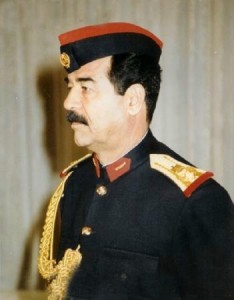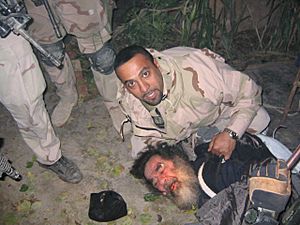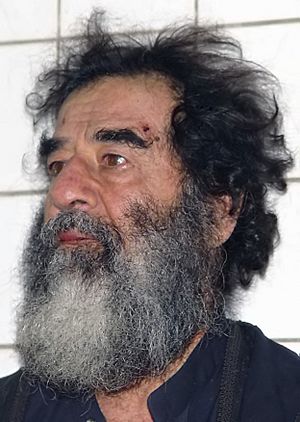Saddam Hussein facts for kids
Quick facts for kids
Saddam Hussein
|
|
|---|---|
| صدام حسين | |
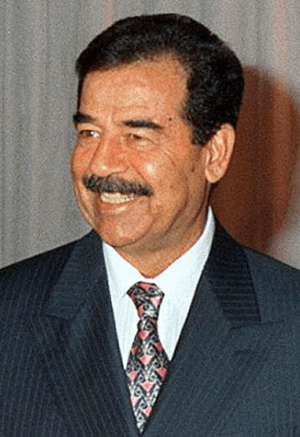
Saddam in August 1998, preparing to deliver a speech for the 10th anniversary of the end of the Iran–Iraq War
|
|
| 5th President of Iraq | |
| In office 16 July 1979 – 9 April 2003 |
|
| Prime Minister |
|
| Vice President |
|
| Preceded by | Ahmed Hassan al-Bakr |
| Succeeded by | Jay Garner (as Director of the Office for Reconstruction and Humanitarian Assistance of Iraq) |
| Chairman of the Revolutionary Command Council | |
| In office 16 July 1979 – 9 April 2003 |
|
| Preceded by | Ahmed Hassan al-Bakr |
| Succeeded by | Office abolished |
| Prime Minister of Iraq | |
| In office 29 May 1994 – 9 April 2003 |
|
| President | Himself |
| Preceded by | Ahmad Husayn Khudayir as-Samarrai |
| Succeeded by | Mohammad Bahr al-Ulloum (as Acting President of the Governing Council of Iraq) |
| In office 16 July 1979 – 23 March 1991 |
|
| President | Himself |
| Preceded by | Ahmed Hassan al-Bakr |
| Succeeded by | Sa'dun Hammadi |
| Secretary General of the National Command of the Arab Socialist Ba'ath Party | |
| In office January 1992 – 30 December 2006 |
|
| Preceded by | Michel Aflaq |
| Succeeded by | Izzat Ibrahim al-Douri |
| Regional Secretary of the Regional Command of the Iraqi Regional Branch | |
| In office 16 July 1979 – 30 December 2006 |
|
| National Secretary |
|
| Preceded by | Ahmed Hassan al-Bakr |
| Succeeded by | Izzat Ibrahim ad-Douri |
| In office February 1964 – October 1966 |
|
| Preceded by | Ahmed Hassan al-Bakr |
| Succeeded by | Ahmed Hassan al-Bakr |
| Vice President of Iraq | |
| In office 17 July 1968 – 16 July 1979 |
|
| President | Ahmed Hassan al-Bakr |
| Preceded by | Ahmed Hassan al-Bakr |
| Succeeded by | Izzat Ibrahim al-Douri |
| Member of the Regional Command of the Iraqi Regional Branch | |
| In office February 1964 – 9 April 2003 |
|
| Personal details | |
| Born | 28 April 1937 Al-Awja, Saladin Governorate, Kingdom of Iraq |
| Died | 30 December 2006 (aged 69) Camp Justice, Kadhimiya, Baghdad, Iraq |
| Cause of death | Execution by hanging |
| Resting place | Al-Awja |
| Political party |
|
| Spouses |
Sajida Talfah
(m. 1963)Samira Shahbandar
(m. 1986) |
| Children |
|
| Signature | |
| Military service | |
| Allegiance | |
| Branch/service | Iraqi Armed Forces |
| Rank | Marshal |
| Battles/wars |
|
Saddam Hussein (born April 28, 1937 – died December 30, 2006) was an Iraqi politician. He was the fifth President of Iraq, serving from July 1979 to April 2003. He also served as Prime Minister of Iraq during two periods: from July 1979 to March 1991, and again from May 1994 to April 2003.
Saddam Hussein led a very strict government that controlled many parts of people's lives. He was removed from power during the Iraq War in 2003, which was led by the United States. He was later found guilty of serious crimes and was executed by hanging on December 30, 2006.
Contents
Early Life
Saddam Hussein was born in the village of Al-Awja, near Tikrit in Iraq. His father disappeared before he was born. His older brother died of cancer when he was 12, which made his mother very sad. Because of this, Saddam was sent to live with his uncle, Khairallah Tulfah, until he was three years old.
When he was 10, Saddam went back to live with his uncle in Baghdad. His uncle was a religious Sunni Muslim. Saddam said that he joined the Ba'ath Party in 1957, when he was 20. The Ba'ath party was an Arab political group that supported socialism.
In 1958, Saddam was arrested and spent six months in prison.
Joining the Ba'ath Party
A year after Saddam joined the Ba'ath party, army officers led by General Abdul Karim Qassim took control of Iraq. The Ba'athists did not like this new government. In 1959, Saddam was involved in an attempt to harm Prime Minister Qassim. Saddam was shot in the leg but managed to escape to Syria, and then later moved to Egypt. He was sentenced to death in Iraq for his actions. While in exile, he studied law at the University of Cairo.
In 1963, some army officers, including members of the Ba'ath party, took power in Iraq in a military coup. However, this new government was quickly removed. Saddam returned to Iraq but was put in prison in 1964. He escaped from jail in 1967 and became an important leader in the Ba'ath party.
Becoming President
In 1976, Saddam was made a general in the Iraqi army. He quickly became a very important person in the government. He slowly gained more and more power over Iraq's government and the Ba'ath party. Iraq's President at the time, Ahmed Hassan al-Bakr, was old and not well. Saddam started to take on a bigger role as the head of the Iraqi government. He soon became the main person in charge of Iraq's foreign policy and represented the country in all international meetings. On July 16, 1979, Saddam forced al-Bakr to step down, and Saddam officially became president.
Foreign Relations
Iraq's relationships with other Arab countries changed a lot over time. For example, in 1977, Iraq and Egypt stopped being friends because Iraq did not like Egypt's peace talks with Israel. However, Egypt later helped Iraq a lot during its war with Iran, which made their relationship better.
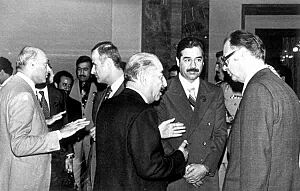
Saddam was known for liking expensive things. He sometimes sent valuable gifts to his friends around the world. For instance, he once sent a Boeing 747 airplane full of presents to an ally.
Saddam only visited two Western countries. In December 1974, he visited Spain. In September 1975, he met with Prime Minister Jacques Chirac in Paris, France. France was a major trading partner for Iraq and provided weapons during Saddam's rule.
Because Saddam Hussein rarely left Iraq, one of his close helpers, Tariq Aziz, traveled a lot and represented Iraq at many international meetings. Saddam wanted Iraq to be a leading country in the Middle East. In 1972, Iraq signed an agreement with the Soviet Union, which sent weapons and advisers to Iraq. Later, Iraq started to have closer ties with Western countries until the Gulf War in 1991.
After the 1973 oil crisis, France became more friendly with Arab countries, and Saddam rewarded them with closer ties. In 1975, Saddam made an agreement with Iran about their shared borders. In return, Iran agreed to stop supporting Kurdish groups who were fighting against Iraq. Saddam also led Arab opposition to the peace agreement between Egypt and Israel in 1979.
In the 1980s, Saddam started Iraq's nuclear program with help from France. The first Iraqi nuclear reactor was called "Osirak" by the French. This reactor was destroyed in 1981 by an Israeli air strike.
Iraq has always had to deal with Kurdish groups in the northern part of the country who wanted their own independent state. Saddam did make an agreement with Kurdish leaders in 1970 to give them some self-rule, but it did not last. This led to fighting between the government and Kurdish groups.
Iran–Iraq War
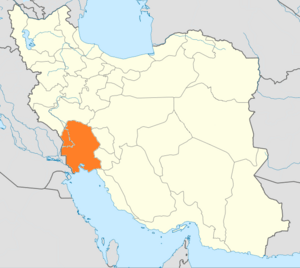
In early 1979, the leader of Iran, Shah Mohammad Reza Pahlavi, was overthrown by the Iranian Revolution. This led to the creation of an Islamic republic led by Ayatollah Ruhollah Khomeini. The influence of this new Islamic government grew quickly in the region, especially in countries like Iraq, which had many Shi'ite Muslims. Saddam worried that these new ideas, which were against his non-religious rule, would spread among Iraq's Shi'ite population.
Saddam and Khomeini had disliked each other since the 1970s. Khomeini had lived in Iraq after being forced to leave Iran. He gained many followers among Iraqi Shi'ites. When Khomeini started encouraging Iraqi Shi'ites to overthrow Saddam, Saddam expelled Khomeini from Iraq in 1978.
After Khomeini came to power in Iran, there were many small fights between Iraq and Iran over the Shatt al-Arab waterway, which separates the two countries. In September 1980, Iraq invaded Iran, first attacking Mehrabad Airport in Tehran. Then, Iraqi forces entered the oil-rich Iranian region of Khuzestan Province.
Image:Shakinghands high.OGG Iraq received support from Arab countries, the US, and Europe. They also got a lot of money from Arab states in the Persian Gulf. Saddam Hussein was seen as a "defender of the Arab world" against revolutionary Iran. Many countries ignored Iraq's actions because they saw Iraq as fighting against a threat. Iraq received military and financial help from its allies.
In the early days of the war, there was heavy fighting. After some initial gains, Iraq's troops started to lose ground to Iran's forces. By 1982, Iraq was mostly defending itself and looking for ways to end the war.
The long, bloody eight-year war ended in a tie. Neither side achieved what they wanted, and the borders stayed almost the same. The oil-rich areas of Khuzestan and Basra were almost completely destroyed. Both countries' economies, which had been strong, were left in ruins.
Saddam borrowed billions of dollars from other Arab countries to fight Iran. This was mainly to stop the spread of radical Shi'a ideas. However, the war actually made Islamic radicalism stronger, both in Arab countries and within Iraq itself. This created new problems between Saddam's Sunni Ba'ath Party and Iraq's majority Shi'a population. Saddam desperately needed money for rebuilding Iraq after the war.
Al-Anfal Campaign
The Al-Anfal Campaign was a series of attacks against the Kurdish people and other groups in northern Iraq. It was led by Saddam Hussein's government between 1986 and 1989. This campaign also targeted other groups like the Shabaks, Yazidis, Assyrians, and Turkomans. Many villages belonging to these groups were destroyed. It is estimated that between 50,000 and 100,000 people were killed during this campaign.
Gulf War
On August 2, 1990, Saddam's forces invaded Kuwait. He first claimed he was helping "Kuwaiti revolutionaries." Later, on August 8, he announced that Kuwait would become a part of Iraq. On August 28, Kuwait officially became the 19th province of Iraq.
When asked why he invaded Kuwait, Saddam first said it was because Kuwait rightfully belonged to Iraq. He also said, "When I get something into my head I act. That's just the way I am." Saddam Hussein was able to do this because his military was very strong. It had been paid for by billions of dollars from Kuwait and other Gulf states, and it had weapons from the Soviet Union, Germany, and France.
US President George H. W. Bush reacted carefully at first. However, there were fears that the invasion would affect the world's oil prices and control of the global economy. The United States and the Soviet Union worked together to pass resolutions in the United Nations Security Council (UNSC). These resolutions gave Iraq a deadline to leave Kuwait and allowed the use of force if Saddam did not obey.
The US and its allies, including countries like Egypt and Syria, sent many troops to the border between Saudi Arabia, Kuwait, and Iraq. This was to surround the Iraqi army, which was the largest in the Middle East. Saddam's officers took many valuable things from Kuwait, even marble from palaces, and moved them to Saddam's own palace.
During the talks after the invasion, Saddam tried to link his withdrawal from Kuwait to Israel giving up occupied territories. This idea divided the Arab world. However, the allies refused to connect the Kuwait crisis with the Palestinian issues.
Saddam ignored the United Nations deadline. So, a group of countries led by the US launched missile and air attacks on Iraq starting January 16, 1991. Israel was attacked by Iraqi missiles but did not fight back. This was to avoid making Arab countries leave the coalition. In February 1991, ground forces, mostly from the US and Britain, pushed Saddam's army out of Kuwait. They then occupied the southern part of Iraq.
The Iraqi army could not compete with the strong coalition forces and their powerful air support. About 175,000 Iraqis were taken prisoner, and over 85,000 were killed or wounded. As part of the peace agreement, Iraq agreed to destroy all its poison gas and germ weapons. It also allowed UN observers to inspect its sites. Trade restrictions would stay until Iraq followed all the rules. Saddam publicly claimed victory at the end of the war.
2003 Invasion of Iraq
In 2003, the United States led an invasion of Iraq. The main reason for the invasion was President George W. Bush's claim that Saddam had weapons of mass destruction. Bush argued that this made Saddam a big threat to Western allies and to oil supplies from the Persian Gulf. Before Bush, President Bill Clinton (1993-2001) had kept restrictions on Iraq and sometimes launched air strikes. He hoped that Saddam would be overthrown by his enemies, but this never happened.
Things changed in the United States after the September 11, 2001 attacks. In January 2002, President Bush said that Iraq, Iran, and North Korea were an "axis of evil." Bush also claimed that Iraq had supported Al-Qaeda, the terrorist group that attacked the United States on September 11.
As the war was about to begin on February 24, 2003, Saddam Hussein spoke with CBS News reporter Dan Rather for over three hours. This was his first interview with a U.S. reporter in more than ten years.
The Iraqi government and military quickly fell apart within three weeks after the US-led invasion began on March 20. The United States tried to kill Saddam with air strikes at least twice, but they missed. By early April, the coalition forces controlled most of Iraq. The Iraqi Army's resistance either collapsed or changed to guerrilla tactics. It seemed that Saddam had lost control of Iraq. He was last seen in a video in Baghdad, surrounded by his supporters. When Baghdad fell on April 9, Saddam could not be found.
Capture and Trial
Even after Baghdad was taken and most of the fighting stopped, Saddam's location was unknown. He was at the top of the "most-wanted list," but he remained hidden. His sons, Uday Hussein and Qusay Hussein, who were expected to take over from him, were killed in July 2003 in a fight with U.S. forces.
On December 13, 2003, in an operation called "Operation Red Dawn," Saddam was captured by American forces. He was found hiding in a hole in the ground near a farmhouse in ad-Dawr, close to Tikrit. After his capture, Saddam was taken to a US base near Tikrit, and then to an American base near Baghdad.
The first photos of Saddam after his capture looked very different from when he was president. He had grown long hair and a long beard. Later, he shaved his beard to help confirm his identity. DNA tests proved that he was indeed Saddam Hussein.
On June 30, 2004, Saddam Hussein and 11 other senior Iraqi leaders were handed over to the Iraqi government. They were to stand trial for crimes against humanity and other offenses. On November 5, 2006, Saddam was found guilty of crimes against humanity and sentenced to death by hanging.
Saddam was executed on December 30, 2006, at 6:05 AM, Iraqi time. He was buried in his birthplace of Al-Awja in Tikrit, Iraq, on December 31, 2006.
Personal Life
Saddam was married three times. His first wife was his cousin, Sajida Talfah. She was the oldest daughter of Saddam's uncle, Khairallah Talfah. Saddam and Sajida had two sons, Uday Saddam Hussein and Qusay Hussein, and three daughters, Rana, Raghad, and Hala.
In early 1997, Sajida and her daughters Raghad and Rana were put under house arrest. This was because they were thought to be involved in an attempt to harm Uday in December 1996.
Saddam Hussein also married two other women. His second wife was Samira Shahbandar, whom he married in 1986. She was said to be his favorite wife. His third wife was Nidal al-Hamdani, who was a general manager at a scientific research center.
Images for kids
See also
 In Spanish: Sadam Huseín para niños
In Spanish: Sadam Huseín para niños


